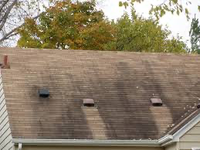This is a bit of a random one, but I wanted to work out this issue for my own education.
We had an aluminium built Caravan that a customer wanted his exterior fully Restoring today. The Caravan had all the usual issues we deal with and are very familiar with, like the normal oxidised surfaces. This is all part of what we do, and know these issues very well.
However, this specific Caravan was a 2010 model and owned my the same owner from new. The customer had always stored his Caravan on his driveway in the same position. This position was directly underneath what I can only assume was an electrical cable. The sort you see looping from house to house.
The customer told me it was a copper cable, which I couldn't confirm, but it wasn't insulated, just a bare cable.
Anyway, the issue we had was where rain water had been constantly dripping on the roof of this Caravan and run down the front panel and a small gap in the awning on one of the side panels. What this had done was eaten into the painted surface to such a degree, that it took me hours of very careful machine polishing and wet flatting until I finally removed all the traces of the damage, thankfully without going through the paint. My customer mentioned that his old Caravan had the same issue, but the water had literally eaten through the aluminium.
I've seen a lot of issues with Caravan and Motorhome surfaces, and explained many of these in depth, including being the first company called by manufactures and dealers with surface issues they either cannot rectify or work out what's happened, but this is something i've never come across in all my years of experience.
I wonder if anyone can explain the correlation between the cable, the water and the almost acidic characteristic effects on the paintwork.
We had an aluminium built Caravan that a customer wanted his exterior fully Restoring today. The Caravan had all the usual issues we deal with and are very familiar with, like the normal oxidised surfaces. This is all part of what we do, and know these issues very well.
However, this specific Caravan was a 2010 model and owned my the same owner from new. The customer had always stored his Caravan on his driveway in the same position. This position was directly underneath what I can only assume was an electrical cable. The sort you see looping from house to house.
The customer told me it was a copper cable, which I couldn't confirm, but it wasn't insulated, just a bare cable.
Anyway, the issue we had was where rain water had been constantly dripping on the roof of this Caravan and run down the front panel and a small gap in the awning on one of the side panels. What this had done was eaten into the painted surface to such a degree, that it took me hours of very careful machine polishing and wet flatting until I finally removed all the traces of the damage, thankfully without going through the paint. My customer mentioned that his old Caravan had the same issue, but the water had literally eaten through the aluminium.
I've seen a lot of issues with Caravan and Motorhome surfaces, and explained many of these in depth, including being the first company called by manufactures and dealers with surface issues they either cannot rectify or work out what's happened, but this is something i've never come across in all my years of experience.
I wonder if anyone can explain the correlation between the cable, the water and the almost acidic characteristic effects on the paintwork.


